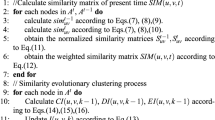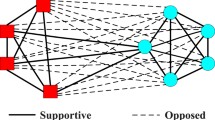Abstract
Signed graphs or networks are effective models for analyzing complex social systems. Community detection from signed networks has received enormous attention from diverse fields. In this paper, the signed network community detection problem is addressed from the viewpoint of evolutionary computation. A multiobjective optimization model based on link density is newly proposed for the community detection problem. A novel multiobjective particle swarm optimization algorithm is put forward to solve the proposed optimization model. Each single run of the proposed algorithm can produce a set of evenly distributed Pareto solutions each of which represents a network community structure. To check the performance of the proposed algorithm, extensive experiments on synthetic and real-world signed networks are carried out. Comparisons against several state-of-the-art approaches for signed network community detection are carried out. The experiments demonstrate that the proposed optimization model and the algorithm are promising for community detection from signed networks.









Similar content being viewed by others
References
Al-kazemi B, Mohan CK (2006) Multi-phase discrete particle swarm optimization. In: Information proceedings with evolutionary computation. Springer, pp 306–326
Barabási A-L, Albert R (1999) Emergence of scaling in random networks. Science 286(5439):509–512
Liu C, J L, Jiang Z (2014) A multiobjective evolutionary algorithm based on similarity for community detection from signed social networks. IEEE Trans Syst Man Cybern. doi:10.1109/TCYB.2014.2305974
Cai Q, Gong M, Shen B, Ma L, Jiao L (2014) Discrete particle swarm optimization for identifying community structures in signed social networks. Neural Netw 58 (P):4–13
Cai Q, Ma L, Gong M, Tian D (2015) A survey on network community detection based on evolutionary computation. Int J Bio-Inspired Comput 6(2):1–15
Chen WN, Zhang J, Chung HSH, Zhong WL, Wu WG, Shi YH (2010) A novel set-based particle swarm optimization method for discrete optimization problems. IEEE Trans Evol Comput 14:278–300
Deb K, Pratap A, Agarwal S, Meyarivan T (2002) A fast and elitist multiobjective genetic algorithm: Nsga-ii. IEEE Trans Evol Comput 6(2):182–197
Fortunato S (2010) Community detection in graphs. Phys Rep 486(3):75–174
Fortunato S, Barthelemy M (2007) Resolution limit in community detection. Proc Natl Acad Sci 104(1):36–41
Girvan M, Newman MEJ (2002) Community structure in social and biological networks. Proc Natl Acad Sci USA 99(12):7821–7826
Gómez S, Jensen P, Arenas A (2009) Analysis of community structure in networks of correlated data. Phys Rev E 80:016114
Gong M, Cai Q, Chen X, Ma L (2014) Complex network clustering by multiobjective discrete particle swarm optimization based on decomposition. IEEE Trans Evol Comput 18(1):82–97
Kennedy J, Eberhart R (1995) Particle swarm optimization. In: Proceedings of 1995 IEEE international conference on neural networks, vol 4, pp 1942–1948
Kennedy J, Eberhart R (1997) A discrete binary version of the particle swarm algorithm. In: Proceedings of 1997 IEEE international conference on systems, man, and cybernetics, vol 5 , pp 4104–4108
Kim J, Hwang I, Kim Y-H, Moon B-R (2011) Genetic approaches for graph partitioning: a survey. In: Proceedings of 13th annual conf. genetic evol. comput, pp 473–480
Kropivnik S, Mrvar A (1996) An analysis of the slovene parliamentary parties network. In: Ferligoj A, Kramberger A (eds) Developments in statistics and methodology, pp 209–216
Lancichinetti A, Fortunato S, Radicchi F (2008) Benchmark graphs for testing community detection algorithms. Phys Rev E 78(4)
Liang J, Qin A, Suganthan P, Baskar S (2006) Comprehensive learning particle swarm optimizer for global optimization of multimodal functions. IEEE Trans Evol Comput 10(3):281–295
Milo R, Shen-Orr S, Itzkovitz S, Kashtan N, Chklovskii D, Alon U (2002) Network motifs: simple building blocks of complex networks. Science 298(5594):824–827
Mitrovic M, Tadic B (2009) Spectral and dynamical properties in classes of sparse networks with mesoscopic inhomogeneities. Phys Rev E 80:026123
Oda K, Kimura T, Matsuoka Y, Funahashi A, Muramatsu M, Kitano H (2004) Molecular interaction map of a macrophage. AfCS Res Rep 2(14):1–12
Oda K, Matsuoka Y, Funahashi A, Kitano H (2005) A comprehensive pathway map of epidermal growth factor receptor signaling. Mol Syst Biol 1(1)
Orman GK, Labatut V (2009) A comparison of community detection algorithms on artificial networks. In: Discovery science, pp 242–256
Read KE (1954) Cultures of the central highlands, new guinea. Southwest J Anthropol 10(1):1–43
Shen-Orr SS, Milo R, Mangan S, Alon U (2002) Network motifs in the transcriptional regulation network of escherichia coli. Nat Genet 31(1):64–68
Watts DJ, Strogatz SH (1998) Collective dynamics of ‘small-world’ networks. Nature 393(6684):440–442
Wu F, Huberman BA (2004) Finding communities in linear time: a physics approach. Eur Phys J B 38(2):331–338
Xie J, Kelley S, Szymanski BK (2013) Overlapping community detection in networks: The state-of-the-art and comparative study. ACM Comput Surv (CSUR) 45(4):43
Zitzler E, Thiele L (1998) Multiobjective optimization using evolutionary algorithms—a comparative case study. In: Parallel problem solving from nature. Springer, pp 292–301
Acknowledgments
This work was supported by the Science Project of Yulin City (Grant Nos. Gy13-15 and Ny13-10) and the Scientific Research Program of the Department of Education of Shaanxi Province (Grant No. 14JK1859).
Author information
Authors and Affiliations
Corresponding author
Rights and permissions
About this article
Cite this article
Li, Z., He, L. & Li, Y. A novel multiobjective particle swarm optimization algorithm for signed network community detection. Appl Intell 44, 621–633 (2016). https://doi.org/10.1007/s10489-015-0716-4
Published:
Issue Date:
DOI: https://doi.org/10.1007/s10489-015-0716-4




